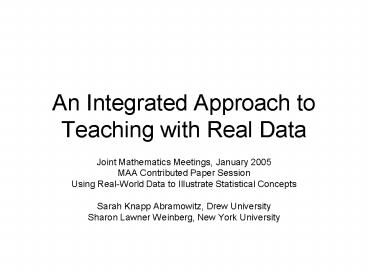An Integrated Approach to Teaching with Real Data - PowerPoint PPT Presentation
Title:
An Integrated Approach to Teaching with Real Data
Description:
An Integrated Approach to Teaching with Real Data Joint Mathematics Meetings, January 2005 MAA Contributed Paper Session Using Real-World Data to Illustrate ... – PowerPoint PPT presentation
Number of Views:85
Avg rating:3.0/5.0
Title: An Integrated Approach to Teaching with Real Data
1
An Integrated Approach to Teaching with Real Data
- Joint Mathematics Meetings, January 2005
- MAA Contributed Paper Session
- Using Real-World Data to Illustrate Statistical
Concepts - Sarah Knapp Abramowitz, Drew University
- Sharon Lawner Weinberg, New York University
2
The National Education Longitudinal Study of 1988
- based on a survey conducted by the National
Center of Education Statistics (NCES) of a
nationally representative sample of eighth
graders - Initiated in 1988, additional waves in 1990,
1992, and 1994 - The goal of the study was to measure achievement
outcomes in four core subject areas (English,
history, mathematics, and science), and personal,
familial, social, institutional, and cultural
factors that might relate to these outcomes
3
Our NELS
- Sub-sample of 500 cases and 48 variables
- Sampled randomly from the approximately 5,000
students who responded to all four
administrations of the survey and who pursued
some form of post-secondary education
4
Beneficial Properties of NELS
- Contains a variety of variables
- Can be used throughout the course because it can
be analyzed by multiple methods - Is appropriately analyzed using a computer
statistics package, modeling practical data
analytic skills. - Demonstrates some of the subtleties in selecting
the appropriate statistical technique for a given
research question - Contains real values, many which are intuitive,
so that interpretation is emphasized and students
gain number sense
5
Selected Variables in the NELS
- Naturally numeric FAMSIZE, the number of
members in the students household - Instrument based composites SLFCNC08, eighth
grade self-concept, and SES, socio-economic
status - Coded categories GENDER, HOMELANG, the home
language background of the student with 1
representing non-English only, 2 representing
non-English dominant, 3 representing English
dominant, and 4 representing English only, and
CUTS12 that represents the number of times the
student skipped or cut classes in twelfth grade
on an ordinal scale with 0 representing never, 1
representing one to two times, 2 representing
three to six times, etc - Likert-type variables TCHERINT, which measures
the level of agreement with the statement my
teachers are interested in students on a
four-point scale.
6
Variety of DistributionsScale Variables
- Approximately symmetric SES and achievement
variables like ACHMAT12 - Negatively skewed SLFCNC08 and SCHATTRT
- Positively skewed EXPINC30, the estimate the
student makes in eighth grade for his or her
income at age 30 and APOFFER, the number of
advanced placement courses offered by the school
the student attends
7
Variety of DistributionsCategorical Variables
- Fairly evenly distributed between categories
GENDER - Unevenly distributed HOMELANG (81 speak only
English at home) and CIGARETT, whether or not the
student had ever smoked a cigarette by eighth
grade (85 indicated that they had not).
8
Examples Using NELS in Paper
- Graphical displays of a single variable
- Measures of central tendency
- Describing relationships between variables
- Independent samples t-test
9
Describing relationships between variables
- Exemplify a variety of magnitudes for the Pearson
correlation - Exemplify relationships between variables with a
variety of levels of measurement
10
Pearson Correlations of different directions and
magnitudes
- Between ACHMAT12 and TCHERINT,
- r -.18. For TCHERINT, a low score indicates
greater perceived teacher interest. - Between ACHMAT12 and ACHRDG12,
- r .64.
- Between ACHMAT12 and FAMSIZE,
- r .02.
11
Other cases of Pearson
- Point-biserial Between ACHMAT12 and NURSERY, r
.13 - Phi-coefficient Between NURSERY and COMPUTER, r
.20
12
Other types of relationships
- Dichotomous variables and those that are nominal
or ordinal with fewer than five categories.
Method contingency table - Ordinal variables and those that are dichotomous,
ordinal, interval, or ratio. Method Spearman
correlation - Nominal or ordinal with fewer than five
categories variables and those that are interval
or ratio. Method Measures of central tendency
13
Examples of other types of relationships
- Between REGION and NURSERY
- Method Contingency table
- Conclusion Approximately 34 percent of the
children who had not attended nursery school
owned a computer in eighth grade, whereas
approximately 56 percent of those who had
attended nursery school owned a computer in
eighth grade
14
Examples of other types of relationships
- Between HWKIN12 and HWKOUT12
- Method Spearman correlation, rho .38
- Conclusion Students who spend more time in
school on homework tend to do so outside of
school too.
15
Examples of other types of relationships
- Between ACHMAT12 and REGION
- Method Measures of central tendency. Because the
distribution of twelfth grade math achievement is
skewed for the Northeast and the North Central,
we compare medians. - Conclusion We see that among students in the
NELS data set, the highest typical achievement is
found in the West (median 59.03), followed by
the Northeast (median 58.74), the North Central
(median 56.50), and then the South (median
55.29).
16
Benefits of the Approach
- Correlation magnitudes are typical
- Can easily study the effects of transformations
such as translation and reflection - Emphasizes choosing an appropriate statistical
technique and the importance of the level of
measurement and the shape of the distribution of
the variable - Demonstrates that several analytical approaches
may be possible
17
Obtaining the NELS data set
- The following website contains a copy of the
paper, this Powerpoint presentation, and the NELS
data set formatted for SPSS. http//www.users.dre
w.edu/sabramow/ - Send an e-mail request to sabramow_at_drew.edu
- Make your own version of the NELS through the
NELS88 page of the National Center for Education
Statistics website, http//nces.ed.gov/surveys/nel
s88/































